As I mentioned in an earlier post, my family recently moved to a new house and I have had a great time setting up a classroom in the basement for my children, ages 9 and 6.
Today I’d like to cover what I’ve done for their language studies; while this is in a home classroom, it’s very similar to what I did in my school classrooms, just smaller.
Let’s get started!
In my earlier post about our homeschool classroom, I posted a picture of the room from one angle, but here it is from another angle:
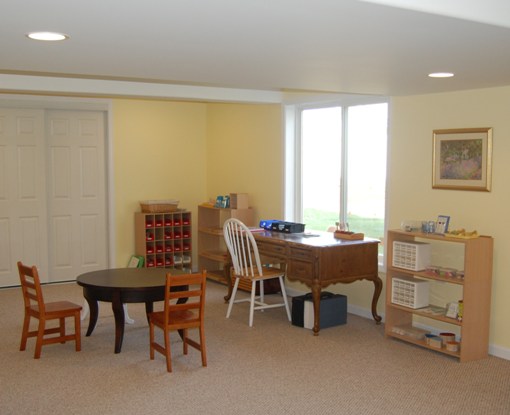
Remembering dark, paneled basements of my youth, I always thought that if I had a basement, I would paint it yellow. It’s not really possible to have a basement that’s too sunny.
Here’s my daughter’s language shelf, which in the picture above is on the far right:
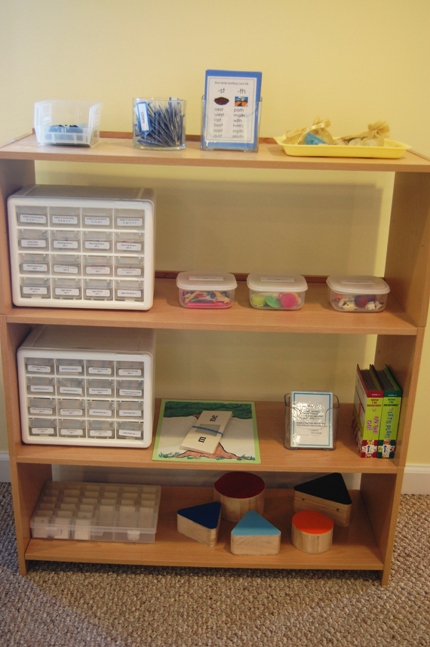
She is in first grade, and has worked through the Pink Series and is in the middle of Blue Series work. Here is the Blue Series shelf:
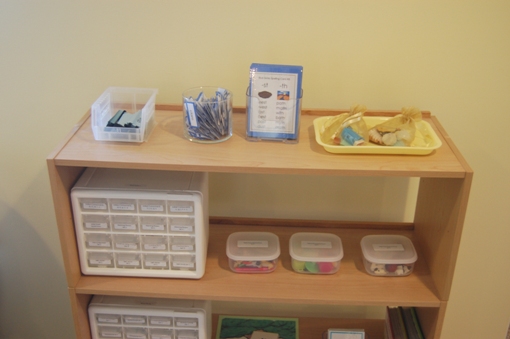
I have Blue Series booklets in the far left container (those are from Montessori Matters and are hard to find, but you can make your own by stapling together cards with Blue Series words on them).
Next are the Blue Series Word Cards, in a clear glass container that used to have a candle in it. (I’ll use just about anything as a container!) Then there are the Blue Series Spelling Cards, in a holder from Office Max (they have them at Staples, too; they are known as literature holders). After that is a tray with two bags containing Blue Series Objects with labels.
The second shelf has a multi-drawer cabinet, which I use for Word Study cards. Next to that are three plural sets with objects.
The third shelf has another Word Study cabinet (I also put things like Initial Consonant and Initial Vowel Sound Cards in those), the Vowel Tree (a free download here under Reading & Pre-Reading), poetry cards from the Poetry Kit, and some phonics readers:
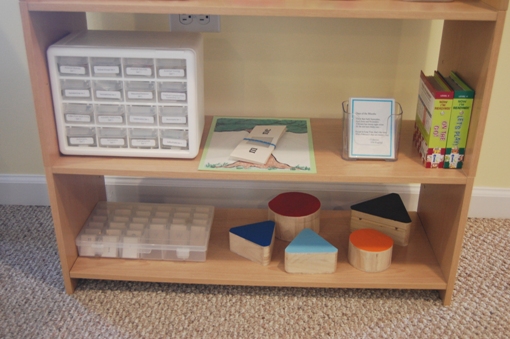
The bottom shelf has a movable alphabet and boxes for five of the nine grammar symbols. Each box has labels and objects inside for grammar study.
I have other materials that she uses (more Blue Series work, nomenclature cards, more phonics readers, etc.) but I have limited space, so I switch things around and keep most of it stored in the large closet at the end of the room.
My son is in 4th grade and does a lot of reading and writing; his language shelf doesn’t have too much on it because more time is spent with things like book reports, creative writing, and research (we have a small room nearby that we use as a library, with lots of reference books and other resources).
Here is his language shelf:
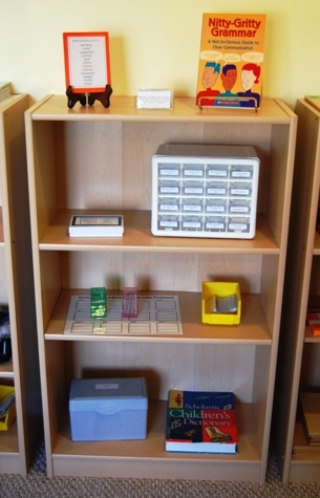
On the top shelf are the Advanced Spelling Cards (on the left) and Creative Writing Command Cards (in the middle).
On the far right of the top shelf is a really nifty book on grammar called Nitty Gritty Grammar. I got it from Scholastic but I’m sure it’s available other places too. It uses funny cartoon-style drawings to illustrate grammar, normally a dull subject. My son loves it and reads a few pages a day.
On the second shelf on the left are some fantastic cards that I only discovered recently: English from the Roots Up flashcards. They have Greek or Latin root words on one side and related English words on the other. A lot of fun to read and very eye-opening. Next to that is a Word Study cabinet with Level 4 work.
On the third shelf you’ll find a Prefix/Suffix Chart (from Montessori Matters, somewhat hard to find). Next to that is a bin with Advanced Studies Command Cards for language.
On the bottom shelf is a container with central theme story cards (like ones on my Free Downloads – Language page). Over the years I’ve made many of them, mostly with stickers and some with clipart/photos. Next to that is a dictionary; with all the writing and research we do my son uses it a lot.
Hope that gives you an idea of how we handle language studies in our homeschool classroom!

